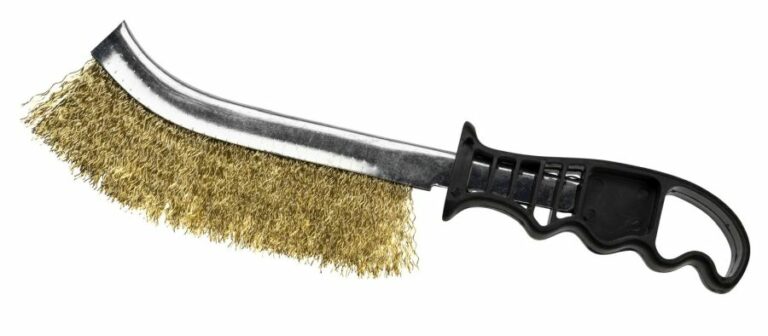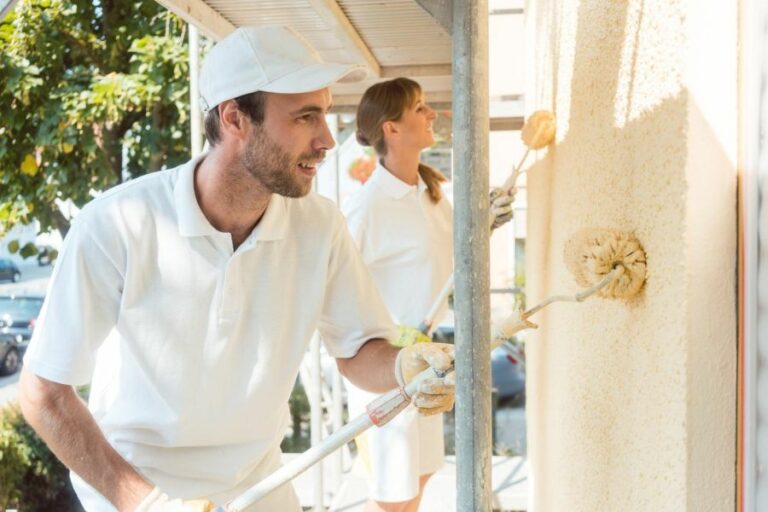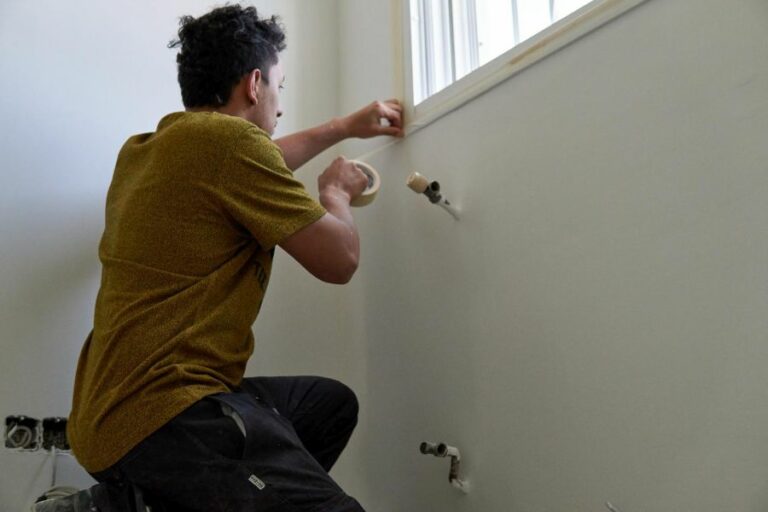Optimal Temp & Humidity For Surface Prep. What Pros Say
Achieving the perfect finish on any surface requires proper preparation, and knowing the optimal temperature and humidity conditions is key to getting it right. Luckily, we have done extensive research and have valuable insights to help you create an ideal environment for your surface preparation needs.
Optimal temp & humidity for surface prep:
Optimal temperature and humidity for surface preparation range between 50°F to 90°F (10°C to 32°C) and 40% to 60% relative humidity, respectively. However, ideal conditions vary depending on the specific material being used, so it’s crucial to follow the manufacturer’s recommendations for best results.

Discover the secrets to achieving impeccable surface preparation by understanding the optimal temperature and humidity levels. Unlock the full potential of your projects by continuing to read on!
Contents
- 1 Ideal Temperature & Humidity for Surface Preparation
- 2 Understanding the Meaning of Optimal Temperature
- 3 Is 72 Degrees the Ideal Winter Heating Temperature?
- 4 Reasons Why 72 Degrees is the Perfect Temperature
- 5 Determining the Optimal Temperature for Heating
Ideal Temperature & Humidity for Surface Preparation
Surface preparation is a crucial step in any painting, coating, or bonding process. The quality of the final finish depends largely on how well the surface has been prepared.
It’s important to understand the correct temperature and humidity levels to ensure that the surface is appropriately prepped for the best possible outcome.
• Importance of Temperature and Humidity in Surface Preparation
Optimal temperature and humidity conditions play a key role in surface preparation, as they can affect both the adherence and drying of various materials. Adhesives, coatings, and primers each have different recommended temperature and humidity levels for the best performance.
– Effect of Temperature
In general, the process should be carried out within a temperature range of 50F to 90F (10C to 32C). However, the ideal temperature range may vary depending on the specific material being used.
- Lower temperatures can cause the material to become thicker and more viscous, making it more difficult to spread evenly.
- Higher temperatures can accelerate the drying or curing process, leading to shorter working times.
It’s important to refer to the manufacturer’s guidelines for the specific material in use to determine the optimal temperature range for each particular application.
– Effect of Humidity
Relative humidity (RH) is another important factor to consider during surface preparation. The percentage of moisture in the air can have a significant impact on how well the adhesive, coating, or primer bonds with the surface.
- Low humidity levels (below 40%) can cause the material to dry too quickly, leading to poor adhesion and an uneven finish.
- High humidity levels (above 70%) can slow down the curing process, prolong the drying time, and increase the chances of defects and inconsistencies.
The ideal humidity range for most applications is between 40% and 60%, but this can vary depending on the material being used. Again, it’s crucial to follow the manufacturer’s recommendations for the best results.
• Tips for Ensuring Optimal Conditions During Surface Preparation
To achieve the best possible finish, it’s essential to maintain optimal temperature and humidity levels during the surface preparation process. Here are some tips to help manage and control these variables:
- Monitor the Temperature and Humidity: Use a thermometer and hygrometer to measure and track temperature and humidity levels in the area where the surface preparation is taking place. Regularly check these levels throughout the process to ensure they stay within the recommended ranges.
- Adjust the Environment: If necessary, use heating, cooling, or humidifying equipment to regulate the temperature and humidity within the work area. This may involve adjusting the thermostat or adding a portable heater, air conditioner, or humidifier to the space.
- Store Materials Correctly: Make sure all materials are stored according to the manufacturer’s guidelines, as their properties could be affected by temperature and humidity fluctuations while not in use. Keep them at consistent and appropriate temperatures to ensure peak performance when needed.
- Check Surface Temperature: The temperature of the surface itself can also have an impact on adhesion and drying times. Use an infrared thermometer or other temperature measuring devices to check the surface temperature, and try to keep it within the recommended range for the specific material being used.
- Adhere to Manufacturer Guidelines: Follow the specific temperature and humidity recommendations provided by the manufacturer for each material being used throughout the surface preparation process. This will help ensure the best possible performance and outcome.
• Additional Resources:
The National Association of Corrosion Engineers (NACE) offers valuable information and resources related to the effects of humidity on surface preparation and coating application, which can be useful for further understanding and managing temperature and humidity requirements during the surface preparation process.
• In Conclusion
Optimal temperature and humidity conditions are vital for achieving a high-quality finish during surface preparation. Taking the time to understand and carefully manage these factors is essential for obtaining the best results for any painting, coating, or bonding project.
Always follow the manufacturer’s guidelines and carefully monitor both temperature and humidity levels throughout the process to ensure a successful outcome. Happy prepping!
Understanding the Meaning of Optimal Temperature
In our day-to-day lives, we often feel the need to regulate our surroundings’ temperature to ensure the comfort and well-being of ourselves, our loved ones, and even our pets.
To achieve this, it is important to understand the concept of the optimal temperature mean and how it impacts various aspects of our lives.
• Defining Optimal Temperature Mean
The term “optimal temperature mean” refers to the average temperature at which a process, system, or living organism can function most effectively and efficiently.
This is known as an equilibrium point, where optimal performance can be achieved, and the desired outcome is realized without compromising safety, health, or longevity.
• Importance of Optimal Temperature Mean in Various Settings
– Human Health and Comfort
Optimal temperature mean plays a crucial role in ensuring human health and comfort. Our body functions most efficiently in a certain temperature range, typically between 68 and 74 degrees Fahrenheit (20 and 23 degrees Celsius) for most indoor environments.
Maintaining the optimal temperature mean in your home or workplace can have a significant impact on your overall health, productivity, and well-being. It also helps in preventing heat-related issues such as heatstroke, fatigue, and dehydration, or cold-related issues like hypothermia and frostbite.
– Agriculture and Horticulture
Farmers and gardeners must understand the optimal temperature mean for their plants and crops to thrive and yield a productive harvest, as each plant species has a particular range of temperatures in which it grows best.
For instance, tomatoes generally require a temperature range of 65 to 75 degrees Fahrenheit (18 to 24 degrees Celsius) during the day and between 55 and 65 degrees Fahrenheit (13 to 18 degrees Celsius) at night.
Deviating from these optimal conditions can lead to poor growth, reduced yields, or even the death of the plants.
– Industrial Processes
Optimal temperature control plays an important role in various industrial processes, such as manufacturing, chemical processing, or food production. Maintaining the right temperatures in these processes can have a significant impact on efficiency, productivity, and overall product quality.
For example, the optimal temperature for curing concrete is between 70 and 80 degrees Fahrenheit (21 and 27 degrees Celsius). Deviating from this range can result in slow curing, cracking, or reduced strength of the cured material.
– Animal Care
In zoos and research facilities, ensuring the optimal temperature mean is essential to promoting the overall health and well-being of animals, as temperature largely affects their metabolism, reproduction, and behavior.
To simulate natural habitats, these institutions must maintain specific temperature ranges for each species, depending on their unique needs.
For instance, tropical birds may thrive in a temperature range of 68 to 86 degrees Fahrenheit (20 to 30 degrees Celsius), while arctic species might require cooler conditions around 32 to 50 degrees Fahrenheit (0 to 10 degrees Celsius).
• Tips to Maintain Optimal Temperature Mean
To ensure the best conditions for any process, system, or organism, consider these practical tips:
- Monitor temperature: Regularly check and measure the temperature using accurate and reliable thermometers or sensors.
- Implement temperature control measures: Install heating, cooling, or ventilation systems to provide a comfortable environment and maintain optimal conditions.
- Insulate spaces: Proper insulation can help retain heat or cold inside a space, reducing the energy needed to maintain the optimal temperature mean.
- Schedule routine maintenance: Keep temperature control systems well-maintained to ensure their efficiency, safety, and reliability.
- Be mindful of external factors: Acknowledge and plan for the impact of weather fluctuations and seasonal changes, particularly in outdoor conditions.
In conclusion, understanding the concept of the optimal temperature mean and its importance in various aspects of our lives is essential for maintaining comfort, safety, productivity, and general well-being.
By implementing appropriate temperature control measures and monitoring conditions regularly, we can promote a healthy and comfortable environment for ourselves, our plants, and the animals in our care.
Is 72 Degrees the Ideal Winter Heating Temperature?
Winter is the time of the year when most energy usage goes towards heating our homes and workplaces. One frequently discussed topic is the ideal temperature setting to maintain throughout the winter season to ensure optimal comfort and energy efficiency.
• The Basic Concept of an Ideal Temperature
The concept of an ideal indoor temperature during winter varies from person to person based on individual preferences and the building’s insulation quality.
The U.S. Department of Energy (DOE) suggests that during winter, the thermostat should be set at or around 68 degrees Fahrenheit (20 degrees Celsius) when you are awake and at home.
When you are asleep or away, it is recommended to lower the temperature by 7-10 degrees Fahrenheit to save up to 10% on heating costs annually.
However, recommending a specific temperature may not fit everyone’s needs, as factors such as personal comfort, age, and health conditions play a crucial role. Therefore, it is essential to find the right balance that is suitable for the occupants’ specific needs and the energy savings objective.
• How Does 72 Degrees Fare as a Winter Temperature Setting?
Based on the DOE’s guidelines, maintaining a thermostat setting of 72 degrees Fahrenheit could imply higher energy consumption.
But, it is crucial to recognize that every individual has a different level of comfort. Here are some factors that might make a case for 72 degrees as an ideal indoor winter temperature:
– Personal Comfort Levels
Various factors, such as age, health, and physical activity, might require a warmer indoor temperature to maintain comfort. For instance, older adults might need higher temperatures to retain body heat, and some medical conditions might make the affected persons sensitive to cold temperatures.
– Insulation and Heating System Efficiency
If your home is well-insulated and energy-efficient, maintaining a temperature of 72 degrees Fahrenheit might not have a substantial impact on your energy bills.
Similarly, if you have an energy-efficient heating system, it might help offset the increased thermostat setting without hampering your budget significantly.
– Outside Weather Conditions
When the exterior temperature dips to freezing or sub-freezing levels, maintaining an indoor temperature of 72 degrees Fahrenheit might be more comfortable for some people.
However, it’s recommended to closely monitor the indoor relative humidity to avoid condensation, mold, or other indoor air problems when increasing the thermostat setting in extremely cold weather.
• Practical Tips for Maintaining an Ideal Indoor Temperature
Regardless of your chosen thermostat setting, there are some general practices that can ensure a comfortable indoor environment while also saving energy during the winter months.
– Utilize Programmable Thermostats
Invest in a programmable thermostat that automatically adjusts the temperature based on your daily routines. This way, you can lower the temperature when you are away or sleeping without compromising comfort when awake and at home.
– Seal Drafts
Thoroughly inspect your home for drafts from windows, doors, and walls. Seal any gaps with weather stripping, caulk, or other appropriate materials to improve insulation and reduce heat loss.
– Use Ceiling Fans
Set your ceiling fans to rotate clockwise at a low speed during the winter months. This helps to push the warm air that rises to the ceiling downward and maintains a more uniform temperature in the room.
– Opt for Energy-efficient Heating Systems
Upgrade your home heating system to an energy-efficient model, such as a heat pump, which provides both heating and cooling functions with optimal energy usage. Implementing an energy-efficient heating system can help offset higher thermostat settings without significant cost implications.
– Layering Clothing and Bedding
Instead of setting the thermostat at a higher temperature, consider wearing warm clothing and using extra blankets, especially during sleep. This way, you can maintain personal comfort without increasing energy consumption.
• In Conclusion
Though 72 degrees Fahrenheit might not be the most energy-efficient thermostat setting during winter, it may be suitable for some individuals based on their personal preferences, insulation quality, and heating system efficiency.
It is important to evaluate and balance your own comfort needs with energy-saving goals.
By effectively implementing tips like drafting sealing, using programmable thermostats, and upgrading heating systems, you can ensure a comfortably warm indoor environment during the winter months while retaining your energy savings objectives.
Reasons Why 72 Degrees is the Perfect Temperature
• The Perfect Balance of Comfort and Efficiency
Experts agree that setting your thermostat to 72 degrees Fahrenheit (22 degrees Celsius) strikes the ideal balance between comfort and energy efficiency. This temperature not only keeps you feeling comfortable but is also wallet and environment-friendly.
Various studies have been conducted to reach this conclusion, including research by the U.S. Environmental Protection Agency.
• Energy Saving Implications
A significant advantage of maintaining 72 degrees Fahrenheit is the energy savings associated with it. It is widely recognized that maintaining this temperature in your living space contributes to reduced energy use, resulting in lower utility bills.
The U.S. Department of Energy recommends setting the thermostat at 72 degrees Fahrenheit when you are at home.
– Cooling and Heating Costs
Air conditioning systems work more efficiently when kept at recommended temperatures, leading to a decrease in overall energy consumption. By setting your thermostat to 72 degrees Fahrenheit, homeowners can reduce cooling costs by up to 10% during warm summer months.
Similarly, during colder months, heating costs can be kept under control by maintaining the suggested temperature. This contributes to a reduction in gas and electricity consumption, which is beneficial for households on a budget.
• Health and Well-being
Maintaining a temperature of 72 degrees Fahrenheit promotes better health and well-being. It contributes to reducing humidity levels, which is particularly important for individuals who suffer from allergies, asthma, or other respiratory conditions.
– Sleep and Comfort
The ideal room temperature for sleep may vary among individuals, but research has found that slightly cooler temperatures, usually between 60 and 67 degrees Fahrenheit, promote good sleep.
However, setting your thermostat to 72 degrees Fahrenheit during the daytime allows for a comfortable living environment while awake, making the transition to cooler sleeping temperatures more manageable.
• Improved Work and Study Environment
Maintaining 72 degrees Fahrenheit in your work or study space is essential for optimal productivity. Research findings support that a comfortable and consistent indoor temperature allows individuals to focus better and work efficiently.
According to a study conducted at Cornell University, an optimal office temperature falls between 70 and 73 degrees Fahrenheit for increased accuracy and productivity. Therefore, 72 degrees Fahrenheit can be considered the ideal temperature for a comfortable and productive work environment.
• Environmental Benefits
By keeping your thermostat at 72 degrees Fahrenheit, you reduce your home’s energy consumption, which has long-term benefits for the environment. Lesser energy consumption means lower greenhouse gas emissions and reduced reliance on fossil fuels, which contribute to a smaller carbon footprint.
– Limiting the Use of Fossil Fuels
The use of fossil fuels in heating and cooling systems has repercussions on the environment, such as air and water pollution, habitat destruction, and climate change.
By minimizing energy consumption through optimal thermostat settings, homeowners can play an essential role in conserving natural resources and preserving the planet for future generations.
• Tips for Achieving and Maintaining 72 Degrees Fahrenheit
To maintain 72 degrees Fahrenheit in your home, consider the following recommendations:
- Invest in a programmable thermostat, which automatically adjusts your home’s temperature according to your schedule.
- Regularly check and replace air filters in the heating and cooling systems to ensure optimal performance.
- Seal any leaks or gaps in your home’s insulation to prevent drafts and maintain comfortable indoor temperatures.
- Utilize energy-efficient window treatments and strategically position fans to distribute air evenly throughout your living spaces.
- Opt for energy-efficient appliances, such as Energy Star-certified products, reducing your home energy consumption and saving on utility bills.
In conclusion, setting your thermostat to 72 degrees Fahrenheit presents numerous benefits, including increased comfort, energy savings, improved health and well-being, enhanced productivity, and environmental conservation.
By adopting and maintaining 72 degrees Fahrenheit as the ideal indoor temperature, homeowners can optimize their living environment while promoting sustainability.
Reason | Explanation |
|---|---|
Comfort | 72°F (22°C) is considered the most comfortable temperature for the majority of people in most environments. |
Energy Efficiency | Maintaining a 72°F temperature in your home can strike a balance between comfort and energy efficiency, reducing energy bills while keeping the space comfortable. |
Regulating Body Temperature | At 72°F, the human body can effectively regulate its internal temperature without having to expend extra energy in the form of shivering or sweating. |
Sleep Quality | A temperature around 72°F can improve sleep quality by helping the body to maintain a comfortable temperature throughout the night. |
Productivity | Studies have shown that 72°F is an optimal temperature for productivity, as it helps to keep individuals alert and focused without the distraction of feeling too hot or too cold. |
Determining the Optimal Temperature for Heating
The concept of optimal temperature is crucial in various applications, such as engineering, industrial processes, and even everyday household tasks. Understanding the concept of optimal temperature for heat can greatly contribute to energy efficiency and maintain the longevity of materials and equipment.
• Understanding Optimal Temperature
The optimal temperature refers to the ideal temperature at which a specific process or operation performs most efficiently, with minimal energy loss and maximum effectiveness.
This temperature can be the point where heat transfer occurs most effectively, materials reach their maximum strength and durability, or a process operates with the highest efficiency levels.
Achieving optimal temperature ensures that resources are used effectively and that the device or process performs to its fullest potential.
For example, the U.S. Department of Energy recommends a home thermostat setting of 68F (20C) during winter for maximum efficiency and comfort. At this temperature, the heating system provides ample warmth without causing excessive energy consumption.
• Factors Affecting Optimal Temperature
Several factors influence the optimal temperature for heat in a system or process, such as:
– Material Properties
Different materials have varying optimal temperatures based on their physical and chemical properties. Metals, for instance, have different melting points, which influence the optimal temperature for heat treatment operations like forging or annealing.
Likewise, polymers may become brittle or excessively soft at different temperature ranges, affecting their use in fabrication processes.
– Heat Transfer Mechanisms
The rate and mechanism of heat transfer also affect the optimal temperature. In conduction, the heat is transferred through a solid or stationary fluid, while convection involves fluid motion facilitating heat transfer. Similarly, radiation transfers heat through electromagnetic waves.
Each heat transfer mechanism relies on temperature differences, which significantly influence the optimal temperature for various applications. For instance, forced air heating systems would require different temperature settings than radiant floor heating systems due to varying heat transfer methods.
– Process or Equipment Configuration
The specific design and configuration of equipment or a process can impact the optimal temperature. Factors such as insulation, internal layouts, and component materials can affect the required heat to achieve maximum efficiency.
• Optimizing Temperature in Practical Applications
Knowing the factors affecting the optimal temperature for heat, we can optimize temperature settings through careful planning and implementation strategies. Here are a few practical recommendations:
– Thermal Insulation
Improving insulation in a given space or system can significantly contribute to achieving optimal temperature. Properly insulating your home or equipment can minimize heat loss, allowing for more efficient heating and temperature control.
In industrial settings, high-quality insulation materials can enhance process efficiency and equipment performance.
– Equipment Maintenance
Regularly maintaining equipment, such as cleaning and ensuring proper component functionality, can lead to better temperature management. For instance, cleaning the filters and coils of HVAC systems or replacing damaged parts can improve their efficiency and support optimal temperature settings.
– Monitoring and Control Systems
Using advanced temperature monitoring and control systems can help maintain optimal temperatures effectively. Sensors and control panels can be installed to monitor temperature fluctuations and adjust accordingly automatically, thus ensuring consistent optimal temperatures without manual intervention.
– Consideration of Ambient Conditions
In certain applications, the optimal temperature should be adjusted based on variations in ambient temperature or environmental conditions. For instance, the cooling method for outdoor equipment may need to be designed differently for hot and humid climates versus cold environments.
• Conclusion
Achieving the optimal temperature for heat in various systems and processes is crucial for energy efficiency, environmental sustainability, and equipment longevity.
By understanding the factors affecting optimal temperatures and implementing practical recommendations from experienced professionals, we can effectively optimize temperature settings, reduce energy waste, and improve overall performance in a wide array of applications.







